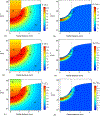A continuum thermomechanical model of in vivo electrosurgical heating of hydrated soft biological tissues
- PMID: 30739950
- PMCID: PMC6366672
- DOI: 10.1016/j.ijheatmasstransfer.2018.07.006
A continuum thermomechanical model of in vivo electrosurgical heating of hydrated soft biological tissues
Abstract
Radio-frequency (RF) heating of soft biological tissues during electrosurgical procedures is a fast process that involves phase change through evaporation and transport of intra- and extra-cellular water, and where variations in physical properties with temperature and water content play significant role. Accurately predicting and capturing these effects would improve the modeling of temperature change in the tissue allowing the development of improved instrument design and better understanding of tissue damage and necrosis. Previous models based on the Pennes' bioheat model neglect both evaporation and transport or consider evaporation through numerical correlations, however, do not account for changes in physical properties due to mass transport or phase change, nor capture the pressure increase due to evaporation within the tissue. While a porous media approach can capture the effects of evaporation, transport, pressure and changes in physical properties, the model assumes free diffusion of liquid and gas without a careful examination of assumptions on transport parameters in intact tissue resulting in significant under prediction of temperature. These different approaches have therefore been associated with errors in temperature prediction exceeding 20% when compared to experiments due to inaccuracies in capturing the effects of evaporation losses and transport. Here, we present a model of RF heating of hydrated soft tissue based on mixture theory where the multiphase nature of tissue is captured within a continuum thermomechanics framework, simultaneously considering the transport, deformation and phase change losses due to evaporation that occur during electrosurgical heating. The model predictions are validated against data obtained for in vivo ablation of porcine liver tissue at various power settings of the electrosurgical unit. The model is able to match the mean experimental temperature data with sharp gradients in the vicinity of the electrode during rapid low and high power ablation procedures with errors less than 7.9%. Additionally, the model is able to capture fast vaporization losses and the corresponding increase in pressure due to vapor buildup which have a significant effect on temperature prediction beyond 100 °C.
Keywords: ablation; electrosurgery; mixture theory; tissue heating.
Figures










References
-
- Song C, Tang B, Campbell PA, and Cuschieri A, “Thermal spread and heat absorbance differences between open and laparoscopic surgeries during energized dissections by electrosurgical instruments,” Surg Endosc, vol. 23, no. 11, p. 2480, Nov. 2009. - PubMed
-
- Narayan P et al., “Factors affecting size and configuration of electrovaporization lesions in the prostate,” Urology, vol. 47, no. 5, pp. 679–688, May 1996. - PubMed
-
- Baggish MS and Sze EHM, “Endometrial ablation: A series of 568 patients treated over an 11-year period,” American Journal of Obstetrics and Gynecology, vol. 174, no. 3, pp. 908–913, Mar. 1996. - PubMed
Grants and funding
LinkOut - more resources
Full Text Sources
